#bottled water industry growth
Explore tagged Tumblr posts
Text
The Future of Bottled Water: Market Forecast and Growth Opportunities in 2024
The bottled water industry continues to grow robustly, driven by rising consumer awareness about health, an increasing preference for convenience, and a growing distrust of tap water quality in many regions. As we look toward 2024 and beyond, the bottled water market is expected to see substantial growth, shaped by several key trends and factors. This article delves into the latest market forecasts, providing detailed insights for market research firms and industry stakeholders.
Market Overview
The global bottled water market was valued at approximately USD 230 billion in 2022, with expectations to surpass USD 310 billion by 2027, reflecting a compound annual growth rate (CAGR) of about 6.5% during the forecast period. The demand is driven by increasing urbanization, rising disposable incomes, and the perceived health benefits of bottled water over sugary beverages.
Key Drivers of Market Growth
Health and Wellness Trends: Consumers are increasingly shifting towards healthier beverage options. Bottled water is perceived as a healthier alternative to carbonated drinks and juices laden with sugars and artificial additives.
Urbanization and Lifestyle Changes: Rapid urbanization and the busy lifestyles of urban dwellers are driving the demand for convenient and portable hydration solutions. Bottled water fits perfectly into this fast-paced lifestyle.
Environmental Concerns and Sustainability: While plastic pollution remains a significant concern, the industry is witnessing a shift towards sustainable practices. Eco-friendly packaging, such as biodegradable bottles and increased recycling efforts, are gaining traction, appealing to environmentally conscious consumers.
Technological Advancements: Innovations in water purification and bottling technologies are improving the quality and shelf-life of bottled water. Enhanced filtration systems and mineral additions are becoming common, catering to premium segments.
Regional Insights
North America: The North American bottled water market is expected to maintain steady growth, driven by high per capita consumption and strong health consciousness among consumers. The U.S. remains the largest market in this region.
Europe: Europe shows a mature market with moderate growth, heavily influenced by environmental regulations and a strong emphasis on sustainability. Countries like Germany and France are leading in both consumption and innovation in eco-friendly packaging.
Asia-Pacific: The Asia-Pacific region is projected to experience the fastest growth. Rapid urbanization, rising disposable incomes, and increasing awareness about health and hygiene are key factors. China and India are the major growth drivers in this region.
Latin America and Middle East & Africa: These regions are also witnessing significant growth due to improving economic conditions and a growing middle class. Bottled water is often seen as a safer alternative to local tap water.
Market Segmentation
The bottled water market can be segmented based on product type, distribution channel, and packaging type.
By Product Type:
Still Water: Dominates the market due to its widespread availability and affordability.
Sparkling Water: Gaining popularity, particularly among younger consumers and those seeking an alternative to sugary carbonated drinks.
Functional Water: Includes added vitamins, minerals, and other nutrients, catering to health-conscious consumers.
By Distribution Channel:
Supermarkets and Hypermarkets: Remain the largest sales channels, offering a wide variety of brands and types.
Convenience Stores: Important for on-the-go purchases.
Online Retail: Rapidly growing, especially post-pandemic, with consumers preferring the convenience of home delivery.
By Packaging Type:
Plastic Bottles: Continue to dominate despite environmental concerns. However, there is a notable shift towards recycled and biodegradable plastics.
Glass Bottles: Seen as premium and eco-friendly, gaining popularity among high-end consumers.
Cans: Emerging as a sustainable alternative, especially for sparkling water.
Competitive Landscape
The bottled water market is highly competitive, with numerous global and regional players. Key players include Nestlé Waters, Coca-Cola, PepsiCo, Danone, and Keurig Dr Pepper. These companies are focusing on expanding their product portfolios, improving sustainability practices, and enhancing distribution networks to maintain and grow their market share.
Future Outlook
The future of the bottled water market looks promising, with sustained growth expected across all regions. Key trends likely to shape the market include:
Sustainability Initiatives: Companies will continue to innovate in eco-friendly packaging and sustainable production processes to meet consumer demand and regulatory requirements.
Premiumization: The demand for premium and functional bottled water is set to rise, driven by health-conscious and affluent consumers.
Technological Innovations: Advanced filtration technologies and smart packaging solutions (e.g., packaging that tracks hydration levels) will become more prevalent.
Emerging Markets: Significant growth opportunities exist in emerging markets where bottled water consumption is still on the rise.
Mergers and Acquisitions: Industry consolidation through mergers and acquisitions will continue as companies seek to expand their market presence and leverage synergies.
Conclusion
The bottled water market is poised for substantial growth in the coming years, driven by health trends, urbanization, and technological advancements. Market research firms should closely monitor these dynamics to provide actionable insights for businesses operating in or entering the bottled water industry. Sustainability and innovation will be key differentiators for companies aiming to capture a larger share of this lucrative market.
#Bottles water market#Bottled water market size#Bottled water market share#Bottled water market forecast#Bottled water market challenges#bottled water market growth#global bottled water market size#India's global water bottle market analysis#Bottled Water Logistics#Bottled Water Vendor#Bottled Water Distributors#Private Label Bottled Water#bottled water market revenue#Bottled water market opportunities#Bottled water customer satisfaction#Bottled water market trends#bottled water industry growth#bottled water industry trends#global water bottled industry
0 notes
Text
Charting Growth Trajectories: Bottled Water Market Revenue and Growth Rate

The bottled water market trends continues to witness significant growth, driven by increasing health consciousness and the convenience factor. Consumers are gravitating towards enhanced hydration options, such as flavored and functional waters, while sustainability concerns are fostering demand for eco-friendly packaging solutions. Premiumization and innovation remain key trends shaping the market landscape.
#Bottled Water Market#Bottled Water Industry#Bottled Water Sector#Bottled Water Market Major Players#Bottled Water Market Analysis#Bottled Water Market Revenue#Bottled Water Market Growth Rate#Bottled Water Market Size#Bottled Water Industry Competitors#Opportunities in Bottled Water Industry#Bottled Water Market Future Outlook
0 notes
Text
The UAE Bottled Water Market is projected to grow at a CAGR of around 6% during the forecast period, i.e., 2021-26. The growth of the market is likely to be driven primarily by the rapidly mounting focus of the UAE government on economic diversification. It, in turn, is leading to massive infrastructural developments to cater to the increasing number of tourists & travelers in the country and propelling the demand for different types of bottled water for excellent hospitality services.
#UAE Bottled Water Market#UAE Bottled Water Market size#UAE Bottled Water Market industry#UAE Bottled Water Market growth
0 notes
Text
A Oui for Stephane; the Nons for Gabriel


When the executive head met the parliament head in Brussels and Paris, respectively. It's interesting how the roles of the duo have switched ever since Q3 2024.
Time: 241125 - 241127
Bonjour à tous! It's Wednesday, 27 November 2024, a big day for the Eurocrats as the MEP voted for the European Commission for a very slight margin; Meanwhile, the budgetary tightrope walk in Paris could boil down to a motion of censure thus the downfall of the government
Welcome to BAT, for the mid-week recap of manoeuvres, and challenges of the former couple at the heart of power.
STEPHANE SEJOURNE
This morning, the European Parliament has just given Ursula von der Leyen's new Commission the green light. That's...that's it. Regardless of how marginal the approval votes was, after weeks of nail-biting hearings, France's very own Stéphane Séjourné is officially part of the team.
Big shoes to fill. The real challenges begin after the appointment, as Séjourné steps into the crucial role of overseeing Europe's industrial strategy. It's a high-stakes game with Russia, China, and the US all jostling for position. Delivering on VDL's promise of a "holistic simplification" approach (with the sheer annoying amount of Euro-red-rapes we have) and making Europe a global industrial powerhouse (our version of MEGA but less toxic), will not be an easy job.

Green industry is the name of the game. Séjourné will work closely with Spain's Teresa Ribera, the new competition and green transition chief. Together, they'll need to find a way to balance economic growth with climate ambitions, all while navigating the tricky waters of EU competition policy. Expect fireworks! (And not the romantic and fun one this time.)
Speaking of (unromantic) fireworks, some MEPs weren't too thrilled with the Commission's rightward tilt. French Socialists voted against the entire college, protesting the inclusion of Italy's far-right Raffaele Fitto as one of the vice presidents. Not a good sign for the future 5 years of cooperation, really.
Again, this is just the beginning. Séjourné has a busy 100 days ahead of him. He'll need to craft a plan to boost Europe's digital startups and help the continent secure its supply of critical raw materials. Plus, there's that little thing about making sure Europe's car industry stays in Europe. He really needs to get it working, with no effort spared, as he claims so!
(I just realised these three sources are written in 3 different languages. Speaking of European diversity!)
GABRIEL ATTAL
Sainte-Catherine agricultural fair! It was Monday, November 25th. While the budget brouhaha continues to consume the Parisian political class, the former Prime Minister and current Renaissance maestro, might as well recharge himself and ventured into the heartland of France, the Orne region to be precise. Was it a desperate attempt to escape the censure storm brewing in the capital or a cunning move to woo the rural vote? Let's examine the evidence, shall we?
The Scene: Attal arrived fashionably late, a mere 45 minutes behind schedule, but hey, even in the world of cattle auctions, a bit of Parisian flair is to be expected. Upon arrival, he was greeted with the full pomp and ceremony befitting a political heavyweight: local officials beaming, senators nodding sagely, a "parade of television cameras" jostling for the best angle, and the local député, Jérôme Nury, looking particularly pleased with himself1.
The Gifts: Attal was showered with local delicacies: a charming basket of regional produce from the mayor and, the pièce de résistance, a vintage bottle of calvados from Nury, who quipped: "It's the Élysée's official supplier, you need to start getting used to it". Was Nury hinting at Attal's presidential ambitions? ●
The People's Champion: Attal worked the crowd like a seasoned politician, charming the locals with selfies and fielding questions from farmers with ease. Whispers of "You're handsome," "He's so good looking" and "He's really young" followed him as he navigated the fairgrounds. Even the normally stern-faced president of the FNSEA Normandie, Anne-Marie Denis, seemed to soften in his presence.
Master of the Moment: Attal showed a willingness to engage with the issues that matter to rural voters, discussing bovine tuberculosis, agricultural regulations, and the ever-controversial Mercosur trade deal. He even tried his hand at the traditional Sainte-Catherine game of guessing the weight of an ox, displaying a playful side that likely resonated with the fairgoers.
Verdict: The mayor of Briouze, Jacques Fortis, who had previously threatened to resign over the town's exclusion from a rural revitalisation scheme, seemed positively smitten with Attal. He declared the streets "full" for Attal's visit and described the former PM as "very friendly, very simple". High praise indeed from a mayor who, just a few months ago, was ready to walk away from it all.
So, was Attal's agricultural adventure a success? Judging by the smiles, the selfies, and the mayor's glowing review, it seems the former PM made a positive impression. Whether this translates into actual votes in future elections remains to be seen. But one thing's certain: Attal is a master of the political stage, and he knows how to play to his audience of Norman farmers.
It is however a bit more complicated when he is playing 3D chess with a broken board – battling rebels in his own camp, haggling over budget crumbs, and trying to keep a government that looks shakier than a Jenga tower in a windstorm. Former pals? They're already plotting their great escape, eyeing up alternative political real estate. Another day, another drama for our young maestro of mayhem! To let us understand the complexity we shall begin with the topic flying all over TV and newspaper headlines:
Budget Battleground
We need to save!: Prime Minister Michel Barnier, facing a record deficit and mounting debt, has proposed a budget characterized by austerity measures. These include cuts to public spending and, most controversially, a reduction in employer contribution relief.
Opposition from All Sides: The budget has been met with fierce opposition from various political factions. The left, led by the Socialist Party and La France Insoumise, condemns it as "austeritarian" and damaging to social welfare. Meanwhile, even members of Barnier's own "socle commun" coalition, particularly Gabriel Attal's EPR group, are pushing back against specific measures.
Sounds boring right?: Well, let's talk about the stakes. The budget fight goes beyond mere numbers. It represents a struggle for political power and a clash of ideologies. The outcome will have a significant impact on France's economic trajectory and the social well-being of its citizens.
The Censorship Sword
Threat of a No-Confidence Motion: The left has explicitly threatened to table a censure motion if Barnier fails to address their concerns regarding the budget. This motion, if successful, could lead to the government's collapse and potentially trigger early elections.
Marine Le Pen's Crucial Role: The outcome of the censure motion hinges on the stance of RN, which holds the largest opposition bloc in the Assembly. Le Pen has expressed strong criticism of Barnier's budget, threatening to vote against it. Her decision could make or break the government.
A High-Stakes Gamble for Everyone: The censure threat creates a complex strategic dilemma for all parties involved. For the left, it's an opportunity to topple the government and potentially gain power. For Le Pen, it's a chance to assert her influence and advance her own agenda. For Barnier, it's a battle for survival, requiring him to carefully navigate the demands of his opponents and his own allies.
Attal's Role: While Attal is primarily seeking concessions, not a government collapse, the line between the two is blurry. His aggressive stance could be interpreted as a calculated gamble: pushing Barnier to the edge to extract maximum concessions, but risking a censure motion that could empower the RN. Adding to the complexity, Attal needs to manage internal disagreements within EPR. Some members are eager for a showdown with Barnier, while others are more cautious. A misstep could alienate potential allies and weaken his leadership. The management of disagreements is particularly essential when he is facing this problem of:
The traitors
A Resignation With a Message: Martine Madelaine and Sélim Denoyelle, former leaders of the Renaissance party in Charente-Maritime, resigned, citing the movement's "rightward shift." They specifically objected to the government's policies on pensions and immigration, arguing that these measures betrayed the party's original values. This resignation highlights the growing discontent among some Macronists who feel the party has abandoned its centrist platform in favour of a more right-wing agenda.
Minister of Ocean Seeking a New Horizon: Hervé Berville, who served as Secretary of State for the Sea in both the Borne and Attal governments, is also charting a course away from the Macronist core. While he maintains loyalty to Macron, he's looking beyond the current administration, expressing a desire to return to his social-democratic roots. Berville has reportedly been in contact with former President François Hollande and former Prime Minister Bernard Cazeneuve, figures associated with the traditional left and plotting for a solid left wing presidential movement in 2027. He's openly critical of the Macronist alliance with the right, particularly on the budget, which he sees as a drift towards "an Orléanist and bourgeois right."
Your ex's bestman, The Justice Crusader: Gone were the days in the Moines Oyster yard, now Sacha Houlie, still invited Stephane Sejourne as his bestman on his own wedding, emerged as the lead dissenter of the formerly Renaissance AN group, and sat as an independent (after the failed attempt to pull more deputies from EPR) and voiced strong opposition to Gabriel Attal's proposed law on juvenile justice, calling it a "very bad text" that undermines the principles of specialized justice for minors. This time, he was successful. With EPR elected officials Stéphane Travert, Belkhir Belhaddad and Lionel Causse, he significantly amended the text in commission, aligning himself with the left and pushing for a more preventative approach, a move that dealt a major blow to Attal and the EPR group, when the person concerned, very interestingly, was not present in thorough the voting process...
Gabriel Attal would like to make this text a marker. He himself did not show up to defend it.
And why betray? As the saying goes, "There are no permanent friends or enemies; only permanent interests." Some started with genuine convictions, believing in a transformative vision, but found themselves gradually disillusioned. Others, always pragmatic, view political parties like career elevators – when one falls, they're quick to find a more promising route.
A classic cocktail blend of opportunistic moves with genuine ideological differences. For our future RE Secretary General, the challenge is clear: craft a compelling vision that speaks to the post-Macron era. It's about creating a narrative and direction that resonates with current members and potentially attracts new supporters. The goal is to provide enough clarity, inspiration, and strategic direction to keep the party united and motivated through this transitional period...And possibly even for a new presidency.
fin.
10 notes
·
View notes
Text
Kim Kardashian’s newest range of products, launched in late 2022—post SKIMS shapewear, post SKKN facewear—is a menacing set of raw concrete forms for storing bathroom products: a gray tissue box, Q-tip tin, wastebasket. Dry, brutal, and mysterious, the items look like you hired one of Gary Larson’s cavemen to decorate your vanity with found objects.
“Having the concrete material and monochromatic design are important for my mental wellness,” Kim said in a recent interview with Architectural Digest. Concrete … for wellness? I imagine her removing her shoes and socks and planting her feet on the gritty sidewalk, grounding herself on the concrete slab, gathering power from the sprawling gray. Kim abandoning her activated charcoal and turning to powdered concrete to treat her gut problems and ensure clearer skin. Jade egg? No, concrete egg. Wellness concrete!
Concrete does not, objectively, promote wellness. It is responsible for 8 percent of the world’s C02 emissions. Concrete dust ruins the lungs of those who inhale it regularly. Concrete cityscapes exacerbate flooding and degrade joggers’ joints. Thanks to a reliance on concrete for construction, the world is running out of certain types of sand. Other high-end brands have sold home products made of concrete, like Comme des Garçons’ concrete-clad perfume bottles, but these usually use the material for its brutal and rough-hewn qualities, not to promote wellness. Kim is an alchemist though. She has taken a material that is undeniably a product of industrial modernity, imbued with a century’s worth of architectural and ideological baggage, and reconfigured it as healthy, intimate, and integral to self-care.
Always ahead of the curve, Kim may have hit on something the rest of us are just coming around to. The idea that we might stop—stop producing plastic, stop building cement megastructures—seems out of the question. Decades of activism, policy work, and think tank-ery have done little to stem the tide of globalized capitalism and the torrents of plastic water bottles, polyester blend clothing, and Squishmallows that discharge from its perpetual motion machines. Blowing up a pipeline or fomenting revolution requires networks of solidarity and logistical capability that most people can’t imagine acquiring. Meanwhile, the microplastics are already in our blood.
What’s left is the alternative that Kim and her concrete line seem to offer: that we can learn how to metaphorically (or literally) digest the toxic brutality of the built environment and transform it into something else—or let it transform us. “I’m just putting little pieces of fibreglass into my cereal to get my body used to it,” tweets one nihilistic wiseass. We’re entering our metabolic era.
Nonhuman systems offer metaphors to help us comprehend and describe our own existence, and structures of behavior we might mimic to cope with intolerable conditions. Over the past decade, you may have noticed mushrooms and fungi embraced as the objects of this kind of attention. The fungal imaginary is powerful because it envisions a world where endless growth is possible, and might even be environmentally beneficial. We can build anything as long as we make it out of mushrooms. Houses, bridges, burgers, clamshell packages for said burgers. Fungi also offer a powerful, nonhuman other we can turn to for inspiration: Mushrooms can grow at the end of the world, form vast underground networks, and offer mystic insight.
More recently, though, metabolic metaphors and processes are emerging alongside, and sometimes overtaking, fungi’s place in the cultural ether. At the more practical end, digestive processes are cropping up as popular solutions to all kinds of crises: compost, vermiculture, bacteria to digest just about anything, biohacks for your gut microbiome. Elsewhere, the metaphor of metabolism is called on to describe the way people process emotions and build feedback loops, and the growth of cities.
Unlike the fungal model, the metabolic imaginary lets us envision a world in which we can get rid of anything. If the drive for endless growth has led to a world too full of bullshit and toxicity, perhaps we can chew it all up and digest it without harm, engineer bacteria to metabolize it, or transfigure it into something new and strange. There is no big other in metabolism, no consciousness to commune with or learn from. Where the fungal era has been about venerating unknowable nonhuman maybe-intelligence and believing that hope can be dredged from ruin, the metabolic era is about submission, subsumption by the great enzyme, the desire for transformative annihilation. Metabolism is an impulse that makes sense at the end of the usable world. If we’ve exhausted our current ways of being and the planet’s existing materials, we must embrace radical breakdown.
One version of creative, apocalyptic metabolism is on vivid display in David Cronenberg’s most recent film, Crimes of the Future. Set in a near future in which environmental degradation and unspecified climate events have led to generalized decay and deterioration, Crimes of the Future imagines what might happen to human digestion. In the film, a sector of the population is evolving to successfully digest and receive nourishment from plastic. At the beginning, we see a young boy crouched in a bathroom taking bites out of a plastic trash bin like he’s compelled by an insatiable craving. Later, we learn of a whole underground organization of plastic eaters who undergo surgery and other interventions in the hopes of spurring their bodies to better metabolize plastic and other pollutants.
In this world, it’s too late for a cleanup. Toxicity is endemic, and the plastic eaters consider the best path forward to be evolving human biology to flourish in the aftermath. The film captures something essential about our zeitgeist in its oscillation between anxiety about how to metabolize everything toxic we’ve created and desire to experience the bodily and social transformation that might accompany this perverse new digestion.
This scenario is only a half step away from our current reality. Efforts are well underway to metabolize the plastic that suffuses our environment. Scientists have found multiple strains of microbes and bacteria that have evolved to digest plastic. Comamonas testosteroni can metabolize complex waste from plants and plastics. Ideonella sakaiensis enzymatically breaks down polyethylene terephthalate (PET). With each new study of microbial plastic-phagy comes a spate of hopeful, if hyperbolic, news articles: “a potential breakthrough for recycling,” “This discovery … could help solve one of the world’s most pressing environmental problems.” People love the idea that we can digest our way out of this mess. The jury is still out on whether it’s possible to operationalize plastic-eating bacteria at scale. There is some movement on this front. Carbios, a well-funded French company developing enzymes that break down plastic, recently announced funding and investment for the world’s first PET “biorecycling” plant, for instance. But many scientists are skeptical about the idea that microbial digestion is a viable solution to the problem of oceanic or terrestrial pollution. For now, plastic digestion at scale remains a pipe dream.
The metabolic turn isn’t just about learning to digest toxicity. It also plays out in fantasies—both desirous and anxious—about being digested. In times of stress, it’s a relief to imagine being crushed and consumed by some other metabolic system. “Why Does Everyone Want Their Crush to Run Them Over?” asked The Cut a few years ago. Being pulverized by your crush is a dream of being relieved of your own agency, destroyed and reconfigured, freed from the pain of consciousness so that you can be reshaped for someone else’s uses. A version of this obliterating impulse is made more explicit in vore, the erotic desire to be swallowed or devoured whole (or, conversely, to swallow or devour another), which is often expressed in role-play or illustrations. In vore, the process of digestion is imagined as a relationship between devoured and devourer—a desire for the kind of intense intimacy only possible when one is literally consumed by another.
Only a short jump from vore is the transhumanist fantasy of having your brain uploaded into the cloud, outrunning death by being absorbed into another system and transformed into bits and bytes. Ray Kurzweil famously advocated for brain uploads to achieve technological immortality, estimating in The Singularity Is Near that “the end of the 2030s is a conservative projection for successful uploading.” Russian entrepreneur Dmitry Itskov’s now mostly defunct 2045 Initiative aimed “to create technologies enabling the transfer of an individual’s personality to a more advanced non-biological carrier, and extending life, including to the point of immortality.” The desire to be consumed and immortalized by technology reveals a belief that your consciousness is uniquely important and your own creation is uniquely powerful. It’s no surprise technologists like Kurzweil lust to be dissolved by their own machines.
Similarly, some of the recent hype around generative AI reveals a conflicting set of responses to metabolic machinery. Large language models and image generators are enormous digestive systems that ingest and transform the raw materials of cultural output and behavioral data on behalf of voracious corporate interests. They suck down the sprawling detritus of human effort and swallow it into the great black box stomach of the AI system, which converts it into something uncanny and instant and profitable. As with transhumanism, some may find this extremely exciting, the emergent opportunity to create the world’s biggest digestive tract, and hence the world’s biggest (and most profitable) collective intelligence. For others, the idea that their labor and creativity is nothing but grist for the generative mill owned and controlled by unaccountable companies is a cause for great anxiety. It’s harder to be optimistic about the future of technological digestion if you’re forced to be an unwilling participant in a voracious process of corporate metabolism.
Kim’s wellness concrete and Crimes of the Future highlight the ambivalence of digestive politics. If the environment is inescapably suffused with pollutants emitted by the biggest and worst companies on earth, then learning to digest this toxicity is a sensible coping mechanism. Of course, there are creative and aesthetic possibilities within the process of toxic digestion—minimalist home goods in Kim’s case, strange new forms of sex and performance art in Cronenberg’s film. We can eke pleasure and art from all kinds of wretched situations—and we should. As Boots Riley put it in a recent interview, “Culture is what we do to make our survival normal.” Still, these visions of metabolism leave us stuck absorbing the excretions of a system that hates us. We have sprawling digestive capabilities. What might it look like to embrace our role as part of a massive and massively weird ecological and metabolic system, and to experiment with the creative and expressive potential of digestion?
Nothing is more natural or strange than metabolism. It happens on many scales, around us and within us, via processes that involve human bodies and microbes and other flora and fauna. I move through the world, digesting it as I go—material entering the mouth hole at one end, exiting the anus at the other—and in between my body does the work of processing, sorting, excreting. I am also here to be digested—built cell by cell inside another’s body and extruded into the world, only to exit back into the earth via a final hole (the grave, the furnace, the mouth of the bear) where I provide fodder for the next stomach. What a trip, what a pleasure.
Digesting with and on behalf of the earth’s ur-metabolic system means wanting more than to function as the unhappy stomach that processes capitalism’s excesses. Embracing digestion as a tool and a metaphor can help us to not only accommodate the horrors of the existing system, but to dissolve it and break it down until it no longer exists in its current form. Some ideas for earth-first digestion are already familiar, thanks to proponents of the circular economy: recapturing waste streams from one process to become inputs for another, designing to ensure reusability. However, ideally digestion wouldn’t just be mobilized to enable human industry and profit. I’m also interested in more creative and psychedelic experiences of metabolism, like collaboration with enzymes, embrace of rot, and joyful submission to the knowledge that humans are just one digestive node of the material world, rather than its apex.
Metabolism can be framed through the lens of mutual aid. While the mainstream medical industry is now catching up, biohackers and anarchist IBS sufferers alike have been experimenting with DIY fecal transplants for years, trading advice and healthy poop samples in the interests of helping each other digest better. It can also be seen as a kind of collective destruction, where communities decide a system or an infrastructure that causes them harm should no longer exist and work together to metabolize it, dissolve it, and perhaps transform its constituent matter into something entirely new. Outside of human-centered processes, composting and rot provide inspiration for rich and generative multispecies metabolism, like worms and microbes working with chemical heat and leafy greens to produce rich and unrecognizable loam. If we’re brave enough, we can even look forward to our own bodies being digested. It’s hard to know what that experience will be like, but let’s try to imagine. Space travel is uncertain, and the singularity is a mirage, so why not stay here, nestled into the cool damp ground. There is much to learn from becoming compost for the original stomach.
#I'm sharing this because I found it interesting and not because I necessarily agree with it#I'm still...digesting this
29 notes
·
View notes
Text
Netsol Water: The Best Commercial RO Plant Manufacturer in Delhi
Along with the growth of Delhi the demand for pure, safe water for industrial applications keeps on increasing. Presently, there is a zeal to have water treatment systems of high capacities particularly from hotels and restaurants, hospitals, and manufacturing facilities. Netsol Water sensed this growing need and positioned itself to meet that challenge head-on. Netsol Water is one of the best Commercial RO Plant Manufacturer in Delhi, providing advance solutions for waste water.
Netsol Water specializes in the ingenuity and excellence of commercial RO plants in its manufacturing. Over time, the company grew to be the preferred business partner for various businesses based around Delhi and other cities. Their high-tech facilities, comprising of experienced engineers, strive day and night to design, manufacture, and install top of the line RO systems that set the benchmark standard for their performance and reliability.
Advanced Technology for Exceptional Performance
A successful base by Netsol Water is about unwavering commitment to advanced water purification technology. Their industrial RO plants feature:
1. Advanced membrane technology: Netsol Water uses high-quality, long-lasting membranes that effectively remove impurities and ensure maximum water production.
2. Energy-efficient pumps: With energy-saving pumps, Netsol Water systems help cut out operational expenditure without jeopardizing its performance.
3. Automation of monitoring and control: Smart sensors and control systems result in optimal running conditions and alarm operators to anything that goes wrong in real time.
4. Pre-treatment as well as post-treatment: Custom filtration stages prior to the RO process and after the RO process, results in improved quality of water besides increasing system life span
5. Space Saving design: Compact modular design allows for easy accessibility, even in the installations of narrower spaces.
Real business benefits from these technological advantages involve higher-grade water purity, reduced energy consumption, and reduced maintenance.
Tailored Solutions to Every Industry
Commercial water purification cannot be a single-type solution. Netsol Water understands this through the diverse quality requirements of different sectors and specific limitations in operations. Accordingly, they are offering the consumers a wide range of customized RO plant solutions to meet the unique needs of various sectors as discussed below:
- Hospitality: Hotels and resorts rely on the water from Netsol Water's RO plants to provide clean, great-tasting water for consumption, cooking, and amenities.
- Healthcare: Hospitals and clinics rely on Netsol Water to provide ultrapure water for critical medical applications as well as patient care.
- Food and Beverage: From bottling plants to commercial kitchens, Netsol Water systems ensure consistent water quality for production and food preparation.
-Manufacturing: Strong RO plants by Netsol Water are the only support industrial facilities have to deliver their process water needs and environmental compliance.
-Pharmaceuticals: High-purity water systems by Netsol Water are needed for pharmaceutical manufacturing and research facilities.
Working closely with clients to understand their unique challenges, Netsol Water develops custom RO solutions that optimize performance and cost-effectiveness for every application.
Unmatched Quality and Reliability
Commercial RO plants may look to describe water purification industries, but Netsol Water has established a good name in all this by offering long-lasting commercial RO plants. Quality is reflected in the strict selection of materials and strict quality control in each and every aspect of operations. Here are some examples:
- High-grade components and materials are used only in Netsol Water's RO systems.
- Strict testing and inspection are conducted on every plant before leaving the factory.
- Comprehensive warranty coverage: Netsol Water offers among the best warranty terms within the industry, indicating the quality of their equipment.
- Thorough installation and commissioning: All technicians are well-qualified and expertly trained to ensure proper installation and optimal operation from the first day.
- Extensive after-sales response: A dedicated service team is geared up to meet all your requirements, answer any questions, and arrange maintenance.
This quality-centric approach towards fulfilling the needs of companies and multiple establishments within Delhi has helped Netsol Water win the hearts of thousands of businesses and, ultimately, to be positioned as the number one manufacturer of the commercial RO plant in the city.
Core Sustainability
The water treatment solutions at Netsol Water keep up with the environmental-friendly concepts driven by the increasing environmental awareness. Their commercial RO plants embrace only those practices from this notion that generate less amount of waste and consume lesser quantities of resources.
A. Advance Technology: With the advanced membrane technology and system design, the recovery rate allows for a maximum amount of pure water production with minimal reject water.
B. Recycling options: Netsol Water offers a reclamation or reuse solution for the rejected water from the process that can help to increase efficiency further by avoiding waste.
C. Chemical-free operation: Most of the RO systems developed by Netsol Water are operated based on physical filtration processes that help minimize the use of harsh chemicals used in the treatment process.
D. Optimization of Energy: Smart control devices and energy recovery devices offer the minimum consumption of power without letting a single drop in performance.
Businesses in Delhi can choose a commercial RO plant from Netsol Water to purify their water exactly as they emphasize more concern towards the environment.
Customer Success Stories
Indeed, the hallmark of excellence in case of Netsol Water is simply found in the happy and satisfied experiences of its customers. Business houses in Delhi have come across various types of expertise from the company while excellent RO plant solutions. Five-star hotel in central Delhi had 30 percent of its operational expenses on water reduced through a Netsol Water commercial RO system that was installed.
- A leader in the nation's pharmaceutical manufacturing industry saw a dramatic improvement in the quality and uniformity of products using the high-purity water treatment solution from Netsol Water.
- A huge food processing facility also achieves 100% compliance to strict regulatory standards through a custom-built RO plant designed by Netsol Water.
These stories and so many more tell the tale of the impact which commercial RO plants have made in business success tales in the city.
Looking to the Future
With the constant growing trend and development, the same is with Netsol Water, as the advancement takes place. The company has always been a forerunner in water purification technology and continues the innovation and improvement of commercial RO plant offerings. According to research and development, Netsol Water will soon launch more high-tech and efficient solutions for water treatment in the near future.
In such a case, for the best Commercial RO Plant Manufacturers in Delhi, the companies would look nowhere else other than Netsol Water. Netsol Water provides unmatched expertise, cutting-edge technology, and a commitment to customer satisfaction that makes it a go-to partner for all commercial water purification needs. In this regard, opting for Netsol Water will allow companies to have a reliable clean and safe supply of water while optimizing their operations and contributing to a more sustainable future.
While water scarcity and quality will remain an issue in the region, it is when such solutions as offered by Netsol Water are ready for presentation that the businesses in Delhi will find themselves leaving all their concerns about staying alive to the solutions that will come. The future city along with its industries now boasts cleaner, better water security with the commercial RO plants leading the way.
#environment#manufacturer#industries#water#environmental#manufacturers#industrial#netsolwater#purifier#manufacturing#industry#wastewater#filter#delhi
2 notes
·
View notes
Text







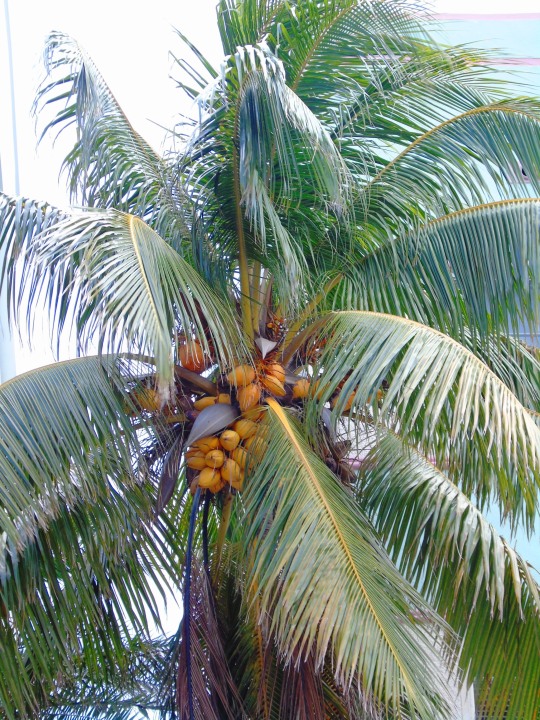

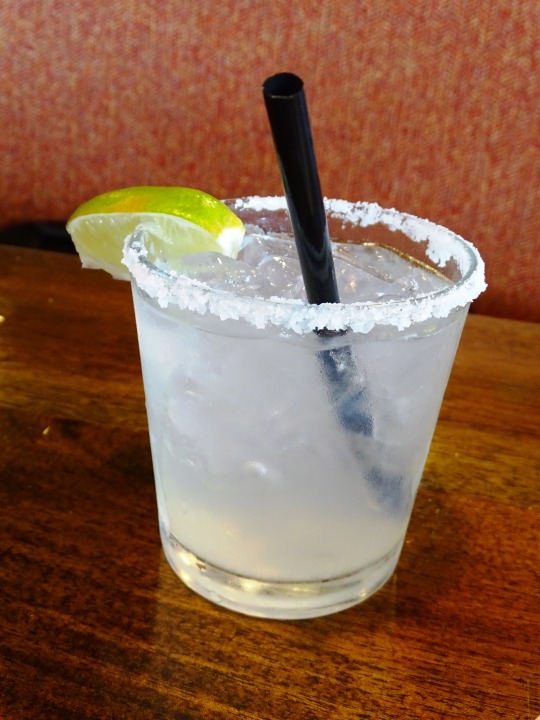





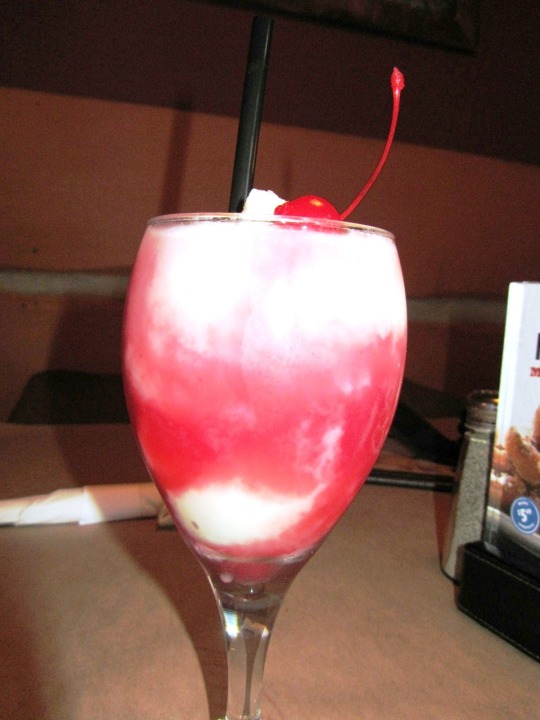

World Coconut Day
Discover the tropical taste and versatility of this round, hairy fruit with a hard shell. From coconut water to oil, there's so much to love about them!
A popular fruit consumed around the world, the coconut is healthy and tasty, and it grows in tropical regions. World Coconut Day celebrates everything that has to do with this delicious and nutritious fruit!
History of World Coconut Day
Coconuts are a food that humans have found sustenance in for at least 2,000 years. Probably native to Indonesia, the name coconut translates to “walnut from India”. While coconuts would have traveled throughout the Indian subcontinent and even to Africa in the early years, they didn’t make it to Europe until some time around the 16th century.
It is likely that coconuts were introduced to Europeans through the Maritime Silk Road, which connected the East with the West. Marco Polo may have been one of the many travelers and explorers who would have brought coconuts back with them.
When the Asia Pacific Coconut Community (APCC) was founded in 1969, it was created in an attempt to help support and promote the tropical countries that are high in growing, producing, selling and exporting coconuts. Located in Jakarta, Indonesia, this group stays connected with the production and export of coconuts. Sharing scientific expertise and coordinating activities within the industry, the members of the APCC are responsible for the growth of more than 90% of the coconuts produced and sold all over the globe.
Founded in 2009, World Coconut Day was started by the Asia and Pacific Coconut Community to promote the activities of coconut growers while raising awareness about the fruit for those outside of the growing community.
The celebration of World Coconut Day offers plenty of opportunities for this important product of the Asia-Pacific region to enter into the forefront of conversation of people around the world!
World Coconut Day Timeline
1st Century BC
Coconuts are present in Indian subcontinent
Historical records from Sri Lanka show that coconuts existed before this time.
16th Century
Coconuts are introduced to Europe
Arriving as many exotic foods did, through the Maritime Silk Road, Europeans were exposed to coconuts through traders like Marco Polo.
1946
Almond Joy candy bar hits the scene
This candy bar combines the sweetness of shredded coconut with an almond and then covers it in delicious milk chocolate.
2004
Vita Coco introduces coconut water
Offering a delicious and nutritious beverage, Vita Coco begins a trend of bottling coconut water and making it commercially available.
2009
World Coconut Day is first celebrated
Started by the Asia-Pacific Coconut Community, World Coconut Day aims to raise awareness and bring harmony to the growth and distribution of coconuts.
How to Celebrate World Coconut Day
Getting involved with World Coconut Day is easy – all it takes is tasting and enjoying this delicious fruit. Consider some of these ideas to celebrate the day:
Enjoy Eating a Coconut
Some people who haven’t grown up around this delicious fruit might be intimidated by its brown, hairy shell. But once it is broken into and the creamy white flesh is exposed, it is a fragrant delight to behold.
First, start by poking a hole in the coconut at the end near the ‘eye’, where the shell is the thinnest. Use a screwdriver or hammer with a clean nail to make the hole. This will allow for the water of the coconut to be drained.
Pro Tip: Strain the coconut water through a cheesecloth and into a cup, and then drink it up!
Once the juice has been drained out of the coconut, one of the easiest ways to break open the fruit is by using a handsaw to cut it in half. Other people might want to simply put it into a sturdy bag and bang it against a stone or concrete until it breaks. This method is a bit messy, but it works.
Once the coconut is open, remove the meat from the shell and enjoy eating it fresh!
Cook or Bake with Coconut
One way to enjoy National Coconut Day without having to go to the trouble of cracking open the fruit is by purchasing the coconut in bags that are shredded or chipped. These are often pre-sweetened and ready to be used in recipes. Since the fruit is a tropical one, and the day falls at the end of the summer, many recipes are cool and refreshing.
Consider cooking or baking with some of these recipe ideas to celebrate the day:
Coconut Cream Pie. This classic pie contains coconut flakes or chips, coconut milk, heavy cream and eggs, and is topped with mounds of sweet whipped cream.
Coconut Ice Cream. This refreshing dessert is so simple, all it needs is 6 ingredients: whipping cream, sugar, vanilla, milk, salt and, of course, shredded coconut.
Coconut Milk Pudding. This delicious recipe is similar to the consistency of flan, but is made with coconut milk, gelatin, mango, butter, grated coconut, condensed milk and other simple ingredients.
Coconut Rice Pudding. A special blend of coconut milk and rice, this dessert is delicious when served with a homemade rhubarb compote or jam. The coconut and rhubarb flavors just meld together on the tongue!
Drink a Piña Colada
A classic tropical drink, the piña colada contains delicious ingredients like pineapple juice, coconut cream, rum, lime juice and ice, all blended together into a delicious frozen beverage. Throw the ingredients in a blender at home and mix it up. Garnish with a drink umbrella and skewer with red cherries for a vibrant presentation.
Try Out Some Coconut Water
A fairly new product on the market, bottled coconut water can be found in many places around the world now. Coconut water is actually the juice or liquid that comes from young coconut plants. Some brands of coconut water that might be worth trying out in celebration of National Coconut Day include Vita Coco, ZICO, Naked Coconut Water, and C2O.
Listen to Some Coconut Themed Music
One fun way to enjoy National Coconut Day is to enjoy a few songs that were written around the theme of coconuts. Try out some of these ideas to get started making a tropical playlist just for this day:
Coconut by Harry Nillson (1971). Probably the most famous song about coconuts, the lyrics are “put de lime in de coconut and drink ‘em both togedder”.
Cocoanut Woman by Harry Belafonte (1957). Released on his album called “Belafante sings of the Caribbean”, this song is about a lady on the island who is selling coconut water.
Coconut Telegraph by Jimmy Buffet (1981). Appearing as the title song on the album of the same name, this song speaks of a Tuesday on the island when information and gossip is exchanged.
I’ve Got a Lovely Bunch of Coconuts by Merv Griffin (1950). With lyrics that make a story out of a coconut toss at a fair, this song is a silly and playful classic from a bygone era.
World Coconut Day FAQs
Is coconut a fruit?
Even though it has the word “nut” in the name, coconut is a fibrous, one-seeded fruit that falls into the drupe, or stone fruit family.
Is coconut oil good for you?
Yes. Coconut oil has a variety of nutrients that are healthy when consumed by humans, including fatty acids, healthy cholesterol, ketones and more.
Do coconuts grow on palm trees?
While coconuts do grow on a certain type of palm tree, not all palm trees are coconut trees.
Is coconut water good for you?
Coconut water offers many healthy benefits, including electrolytes, magnesium, potassium, antioxidants and more.
Should coconut oil be refrigerated?
Coconut oil is long-lasting, up to two years, and does not need to be refrigerated.
Source
#Coconut Margarita#Banana Annies#Chris' Outrageous Cheesecake#World Coconut Day#WorldCoconutDay#Coconut Cake#Thai Coconut-Lime Chicken#Piña Colada Cake Cheesecake#Roasted Coconut Donut#Coconut Cream Pie#Coconut Cream Pie Cheesecake#travel#original photography#vacation#food#dessert#restaurant#Häagen-Dazs Coconut Ice Cream Sandwich#USA#Canada#2 September#Miami Beach#Colada Kaboom
2 notes
·
View notes
Text

POPPIN MORE BOTTLES TONIGHT
"James G. Watt, who as President Ronald Reagan’s first Interior secretary tilted environmental policies sharply toward commercial exploitation, touching off a national debate over the development or preservation of America’s public lands and resources, died on May 27 in Arizona. He was 85.
His son, Eric Watt, confirmed his death in a text message but declined to cite a cause.
After taking office in 1981, Mr. Watt was asked at a hearing of the House Interior Committee if he favored preserving wilderness areas for future generations. He had been picked by Reagan from a Denver legal foundation that had often challenged the rules and policies of the department he now headed. Critics called him a fox in the hen house.
Mr. Watt’s response startled some committee members, but seemed to explain his intention to ease restrictions on the use of millions of acres of public lands. “I do not know how many future generations we can count on before the Lord returns,” he said.
The remark was revealing. Mr. Watt, a born-again Christian and a lifelong Republican, saw himself as a servant of God and prayed with colleagues at work. But it raised questions over whether he would be motivated by conservative political judgments or religious convictions, or both.
It also hinted at a side of Mr. Watt that was not apparent at first: a verbal propensity to shoot himself in the foot. In unguarded moments over a 33-month tenure, he suggested that liberals were un-American and that the popular Beach Boys rock band was unwholesome. He likened his critics to Nazis and Bolsheviks, and insulted Black people, women, Jews and handicapped people.
In one of his first official pronouncements, Mr. Watt declared that Interior Department policies over years had swung too far toward conservation under the influence of “environmental extremists,” and away from the development of public resources that he said was needed for economic growth and national security.
He soon transferred control of many of the resources to private industry, restoring what he regarded as a proper balance to the nation’s patrimony. He opened most of the Outer Continental Shelf — nearly all of America’s coastal waters — to drilling leases by oil and gas companies. He widened access to coal on federal lands, and eased restrictions on strip-mining, which scarred landscapes and was cheaper than cutting deep mine shafts.
He increased industry access to wilderness areas for drilling, mineral mining and lumbering; gave private owners of hotels, restaurants and shops wider rights in national parks; curtailed the program to protect endangered species; cut funds to acquire land for national and state parks; and added money to build roads, bridges, hotels and other man-made structures in the parks."
9 notes
·
View notes
Text
The data is part of a report by FEDIAF (the European Pet Food Industry Federation), which includes international companies such as Mars, Inc.
5.1% is the annual growth in the number of families in Europe that keep pets, according to the latest FEDIAF report for 2023, part of which is Mars, Inc. The total number of households with four-legged friends is 91 million. This is 46% of families on the Old Continent, according to data from the European Federation. In the leading position in Bulgaria among pets are cats, which are 815,000, followed by dogs, which are 750,000.
Considering this information and at the height of summer, the experts at Mars, Inc. have prepared a list of some useful tips for the owners of four-legged friends who do not want to part with them during their summer vacation. The tips include all the most important things that carers need to think about before departure. Starting with choosing a suitable destination, to providing a balanced diet for pets to feel as comfortable as possible during new and unknown adventures for them.
5 Tips for Traveling with Pets from Mars, Inc.:
1. Destination: Before planning a holiday with your pet, it is important to research the destination - what is the climate like, are there enough activities to do with your pets, is there access to a vet nearby. For example, if you are headed to the sea, check in advance if there are any nearby beaches where pets can walk freely.
2. Transportation Check the conditions for traveling with animals on your chosen transport. Prepare the necessary medical documentation if necessary and make sure your four-legged friend's passport is in order. In case you will be traveling by car, make sure that the animal feels comfortable. If it has no experience being transported in a car, it is advisable to do a few sightseeing tours of the city so that the pet gets used to it before the trip.
3. Accommodation More and more hotels and guest houses are now accepting pets, but it is important to check their pet conditions, additional fees and possible restrictions to avoid unwanted inconveniences upon arrival.
4. Food It is possible that changing the familiar atmosphere can be stressful for pets. To avoid additional stress for your furry friend, be prepared with plenty of food and treats that your pet already knows and loves. Products such as Whiskas, Pedigree, Perfect Fit, Sheba, Dreamies, Cesar and other well-known brands from the Mars, Inc. portfolio. are perfect for the occasion. The wide selection of nutritious and environmentally-friendly packaged food produced from sustainable sources contains everything you need to keep your pets happy and healthy. Also, make sure you provide them with enough water in the summer heat. It is recommended that you also bring a portable pet bowl or bottle. To make sure your pet feels good and adapts to the new environment. Try to stick to the meal, walk, and rest schedule you're used to at home.
5. Have fun This is also the most important of all tips. Vacationing with pets is a perfect opportunity to create unforgettable memories and strengthen your bond with them even more. Knowing the temperament and moods of your pet, do not be afraid to improvise and get as many positive emotions and fun moments as possible from your joint adventures.

5 notes
·
View notes
Text
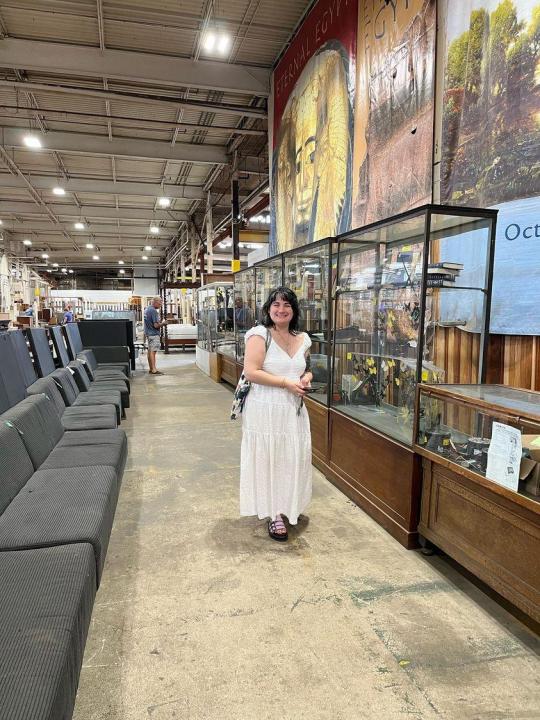


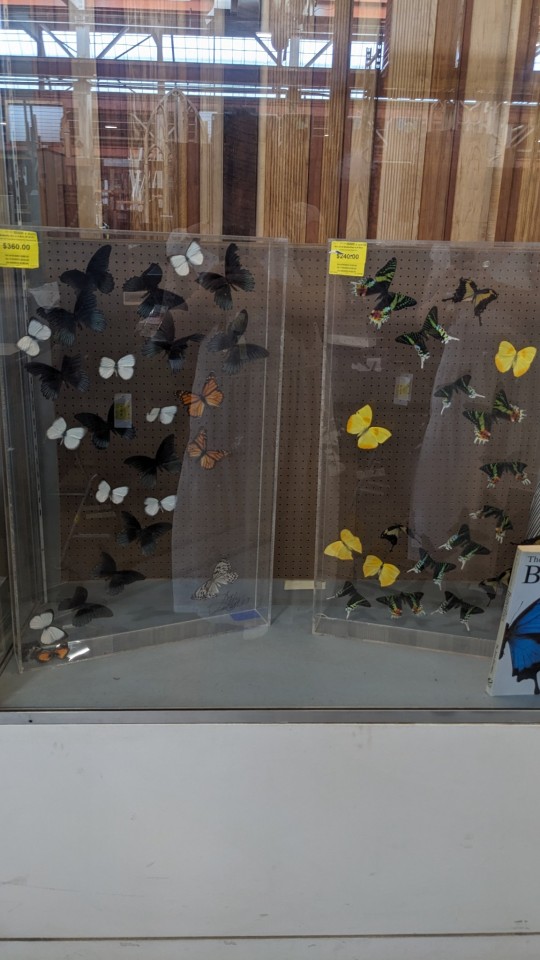
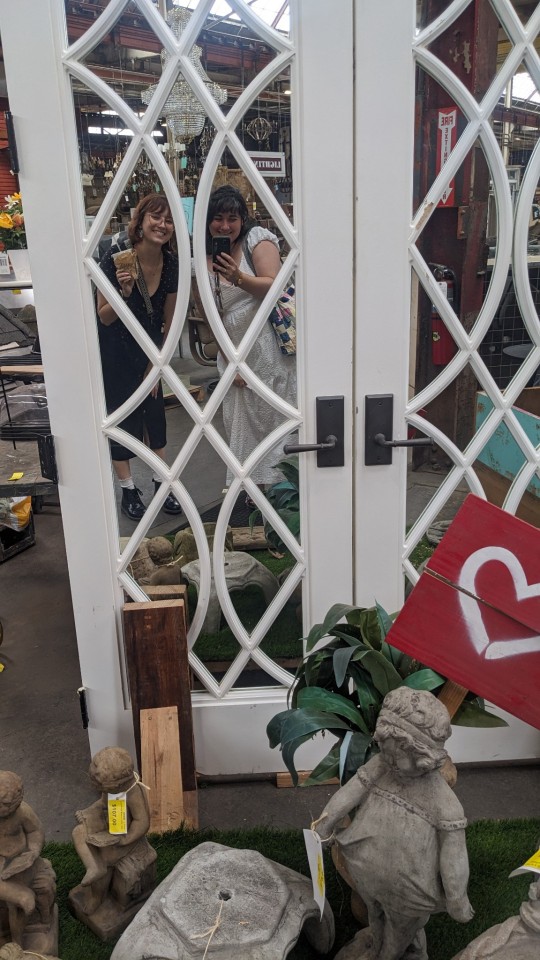



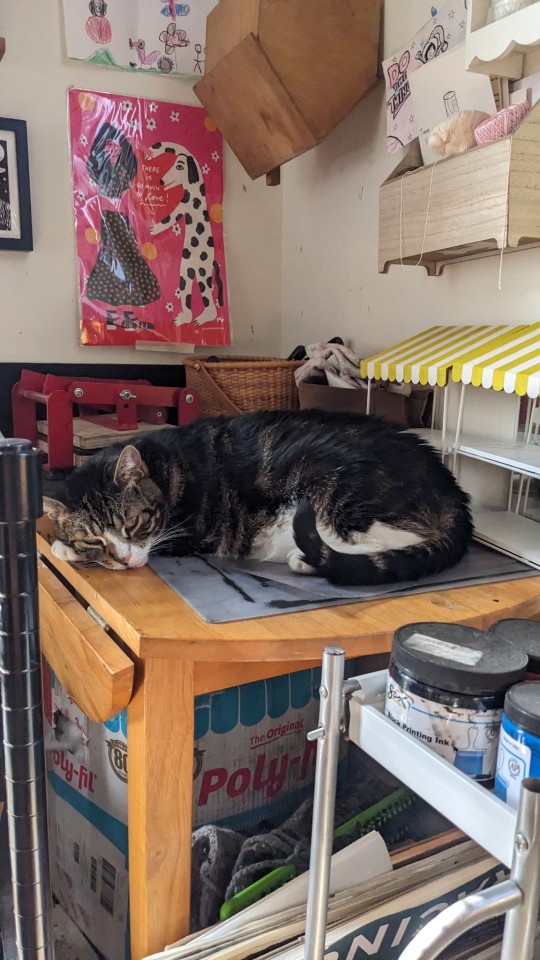

Jess just got back to her house. I am really glad she came. And today was a lot of fun!
I slept alright. I did not want to be awake when my alarm went off but I knew Jess was in the other room waiting.
So I forced myself up. I got washed up and dressed and felt really pretty in my reception dress. I just love the way this dress fits.
We chilled on the couch once I was dressed and I tried to shake off how tired I was. I kept spacing out. Jess was ready to go though so we headed out to go to Golden West.
We got to Hamden right before 9. We parked around the corner, between two other Subaru Crosstreks which I thought was hilarious. We checked the free library and a cicada landed on me! First one I've seen this year! Jess ran away and yelled at me for touching it. But cicadas are just dumb puppies.
Breakfast was good! Jess got tacos and I got a quesadilla. I didn't like my potatoes but that was alright. I would eat half of mine and saved the rest for later. It was just nice to talk and sit together and day dream about things we hope for. My stomach was hurting a bit but I was still having fun. Jess got a latte to go and I got a cup for my diet coke.
And then we were off. To second chance.
We didn't end up buying anything but I had a blast looking. Even though it was stupid hot in there, despite their industrial fans, it was sweaty and my upset stomach wasn't helped. But there was fun stuff to see. Jess was slightly discouraged because she didn't find anything she loved but I also think that because it's real, she bought a house, it feels like there is to much pressure so it's hard to pick anything. It was still fun to look.
Once we decided we were entirely to hot we headed out. It was drizzling and that felt nice.
I decided we would go to value village.
Jess found a book right away and I found someone I used to work with at the science center. I chatted with her for a few minutes. And tried to find some dear america books but no luck. I did find a yellow shirt dress and a leather tool belt holder. Which I guessed was for an electrician and I was correct when I googled it later!
We left there and we're giggling and just having a great time. We had one more chore, getting my replacement yarn.
So we drove further into Glen Burnie to go to Michaels. Where I was able to get the black yarn and another ball of the speckled white which I had wanted. And with the coupon I had I also got some clearance items (more rainbow loom rubber bands, some hot glue sticks) and the elastic I wanted for the price of just the yarn so it's like I got it for free. Amazing.
Jess got two mugs for her new kitchen and got a giant glass pumpkin drink dispenser. Which was super cool and I'm excited to see how she uses it.
We went next door to Marshalls next. Jess would get a cute piece of Tupperware. I did not get anything but I enjoyed looking. I wanted to buy another water bottle but I did not. Growth.
We headed back to the apartment after that. Moved the stuff Jess got to her car and we brought my stuff inside. I was happy to be back in the AC. It was so stupid humid outside.
We had leftovers for lunch. And Jess showed me more of her Pinterest. I worked on figuring out how to attach the elastic I got to my doc sandals so they would have a back and it took some trial and error but it worked and I was so round of myself. I may add another strap but I really think this will help with the pain on the top of my feet.
I would also work on some knitting. And then Jess fell asleep for a little while. I left her to sleep until 330. Which was when she said she wanted to get on the road. And once she was awake she was surprised she had slept. I walked her to the car. Big hugs. And a promise that the next time I'll see her it'll be at her new house??! I'm so proud of her.
I went back upstairs. I worked on knitting. I enjoyed the ac. And not long after Jess left, James came home.
I was very happy to see them. They were being very silly. We talked for a while. I shared some things from today. And eventually James decided to go for a walk.
While they were gone I took a shower. I washed my hair twice and it was very good. But I still felt sweaty after. It took me a while to find a good temperature. And I would start working on some other projects. Trying out some sewn faces on some bears. Which I for sure don't have a handle on but I'm trying. I need a smaller embroidery hoop I think. And James would come home and would help me unpack my market box so I could refresh it and take out any old papers or things. And I fixed the part of my sign for messed up. I also moved the stickers into their new display and I'm very pleased.
James would make me nachos for dinner. And they would have their own quesadillas. It was just a chill evening.
James went to paint their nails and I kept working in the studio. I started a new knitted loom idea. I'm gonna finish the squares for my one blanket hopefully this week or next. And then I have to decide on the pattern because I'm not in love with the checked. I want it to be funkier. So maybe it'll be sections. We will see.
Now I am in bed. And ready to sleep. I am not sure if I will stay at camp tomorrow but I probably will. I am looking forward to my projects. And it's going to be a good week. I've decided.
Sleep well everyone. Take care of yourself!!
3 notes
·
View notes
Text
Bottled Water Market Size: Past, Present, and Future Perspectives
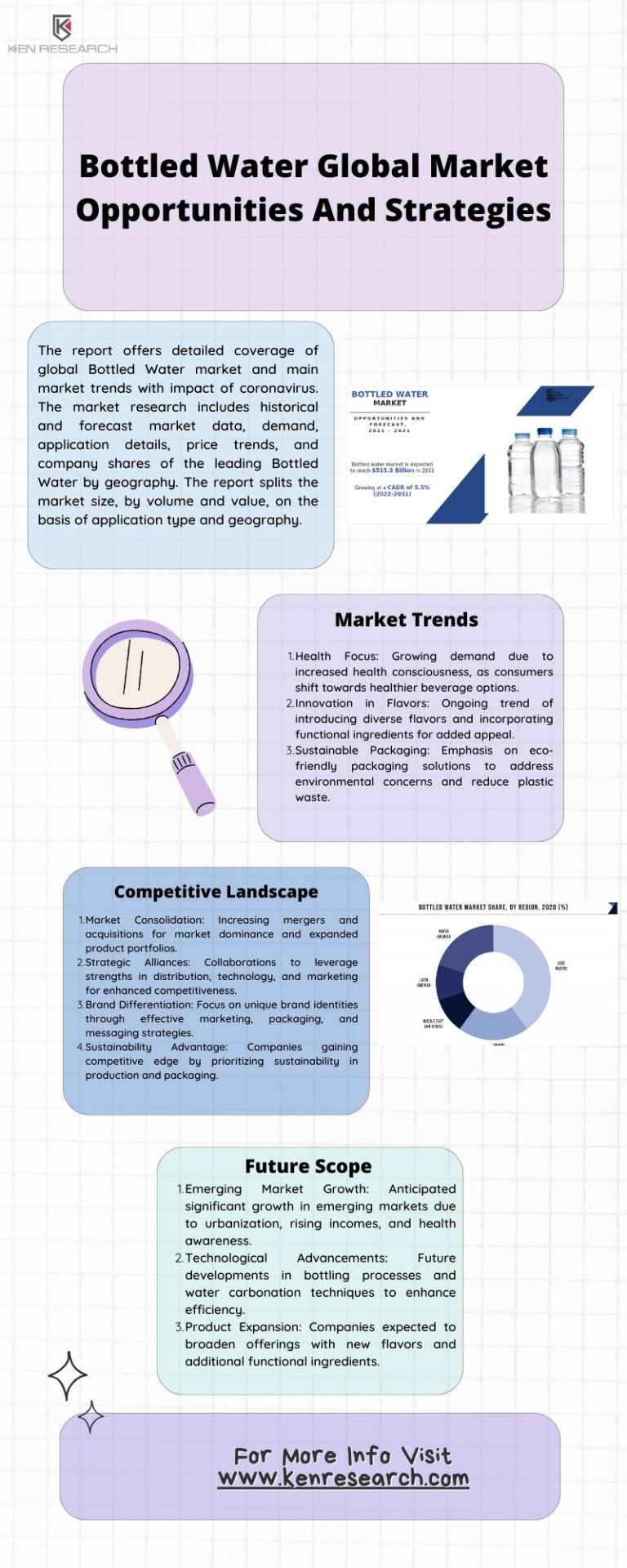
The bottled water market offers a diverse range of purified, mineral, flavored, and enhanced water options catering to varying consumer preferences for hydration. With growing health consciousness and convenience demands, it continues to thrive globally, driven by factors such as portability, sustainability initiatives, and innovative packaging designs.
#Bottled Water Market#Bottled Water Industry#Bottled Water Market Analysis#Bottled Water Market Size#Bottled Water Market Segmentation#Bottled Water Market Trends#growth of Bottled Water industry#bottled water supplier#premium bottled water#bottled water brand names#bottled water report#bottled water analysis#bottled water market growth#bottled water market segmentation#bottled water market share#bottled water market size#bottled water market trends
0 notes
Text
Respectfully, these concerns are exaggerated:
ChatGPT uses so much energy that the US is literally reversing course on coal and gas usage to make up for it. At this point, solar power is cheaper than building coal and gas. This is why 86% of new power sources created last year across the globe were renewable (irena.org). In addition, most major tech companies have committed to being 100% renewably powered. Lastly, how the US and other countries primarily source power is not determined by ai needs, or even the tech industry in general, but rather by politics. (e.g. The US just elected trump, who is likely to push for fossil fuel usage and stymie renewables growth. Other countries aren't so stupid.)
In Santa Clara, for example, data centers used 60% of the ENTIRE CITY'S electricity. This is in the heart of silicon valley, so naturally they have a disproportionately high number of data centers. This is not typical. also, how many of those data centers were for AI vs any other type of digital use, like bitcoin mining (which is actually a scourge), managing the huge online gaming industry, or even mundane internet stuff, like running the tumblr website.
ChatGPT uses 1-3 bottles of water for cooling for every query you put into it. This is FRESH WATER, which is evaporated and eventually mostly returns to the ocean, effectively removing a lot of it from our already dwindling fresh water supply on the planet. This is what I found: "10-50 queries consumes 500 millilitres of water" (oecd.ai), which is around half a bottle. Let's average it 30 queries for a half bottle = 1 query uses around ~17ml, or around [edit: 1.6%] of a bottle of water, or around 1% of OP's claim.
It also consumes 17 THOUSAND TIMES more electricity than the average American home. Again, this isn't really accurate. Part of the issue is that AIs use power in two distinct ways: Firstly, the training session. This is "teaching" the AI to work. It happens once, at the start, and is indeed pretty computational/energy intensive. e.g. GPT3 likely used over 1,000 MWh for it's training. But this is still equivalent to the energy usage of just 120 US homes. The second stage of AI is *using* the ai, asking it questions, etc. This part is MUCH less energy intensive, with query's requiring 0.3 - 1 Wh per query, depending on complexity. Assuming a query requires a full 1Wh, that means each query is equivalent to running a 100W lightbulb for 6 minutes. This is not a lot.
The AI boom wastes so much electricity that we are very immediately risking US cities having to have rolling blackouts just to keep up with the energy demands, as early as NEXT YEAR This article presents a potential concern, not a reality. They are worried about the pace of new power installations keeping up with AI demand. This is a fair concern, of course, but all it really says is that we need to ensure that we're growing our energy resources quickly. And again, whether this happens is not really about the AI but about political decisions. (Frankly, I'm more concerned about this with Trump in charge but I think other countries will be fine.)
Gen AI's water usage is projected to hit 6.6 BILLION meters cubed by 2027 This is a lot but it's also very small on a global scale. Consider that just the pistachio farmers in just California alone use 2.5 BILLION meters cubed of water each year. Beef production alone in the US alone uses over 100 BILLION m3 of water each year. So yes, 6.6B m3 is a lot - but it's also a tiny amount for what it offers in useful work. Lastly, and more important than all the previous points, is that the OP analysis is based on the status quo. It's projecting current requirements into the future. But tech is not static. It improves each year. Tech oligarchs are heavily incentivized to reduce their water and energy footprints for a variety of reasons, most importantly, that it saves them money. At the same time, the history of computing shows regular improvements in things like energy efficiency and computing efficiency. In other words, it makes sense to expect AI tech to be much more energy and water efficient as time goes on. And at the same time, things like total power available are growing with the growth of sustainable energy, battery tech, etc. What's more, AI is already being used to help us achieve these goals: To design more efficient computers, more efficient energy tech, and even for new techs, like water-from-air generators that unlike older versions based on condensers (like in AC unit), these new ones can provide water even in extremely dry conditions, while using very little energy. This may well solve the global water crisis in the coming years and make the 'data center water issue' into a truly non-issue. Or, let me quote the first article OP linked to: "Tom's Guide AI expert Ryan Morrison said of the new reports: "While it is true that there is a significant environmental impact from AI, largely driven by the massive compute requirements, it will become less of a problem as models get more efficient and custom chips take over from power-hungry GPUs... AI may well also be the solution to its own energy problem, as well as the wider energy problems facing society. As the technology improves it will be used to design more efficient compute and cooling systems that minimise the impact on the environment. The designing the path to net zero may require AI."
So, in short: Yes, AI does have intense energy and water requirements. And yes, this will require sensible gov't policy to avoid problems. (and yes, I expect trump to do poorly on this.) And yes, we should all be paying attention and demanding good policy. However, the concerns have been overblown, presenting without context, generally ignore the regular gains in this field, and ignore how the 'problem', ai, is already proving itself part of the solution.
Idgaf if you don't want to write essays for school. I don't care if you don't want to write corporate emails yourself. I don't care if you can't draw well, I don't care if you can't write well, I don't care if you just really really want to talk to your favorite fictional character but don't want to RP with a real person because you have social anxiety or whatever
If you're still regularly using generative ai, chatgpt or midjourney or character.ai or literally whatever the fuck, im personally blaming you when my utility prices start going up.
43K notes
·
View notes
Text
Glass Bottling Plant Manufacturers: Leading the Future of Sustainable Packaging
The demand for sustainable and high-quality packaging is driving businesses to invest in glass bottling plant solutions. Glass bottles not only enhance product appeal but also ensure purity and recyclability, making them a preferred choice for premium beverages and water.
As one of the top glass bottling plant manufacturers, Canadian Crystalline leads the industry with cutting-edge technology, precision engineering, and fully automated systems. Their expertise in designing high-efficiency glass bottling plant ensures seamless production, quality assurance, and sustainability.
Choosing the right glass bottling plant manufacturer is essential for long-term success. With Canadian Crystalline, businesses gain access to world-class solutions that enhance efficiency, reduce waste, and support eco-friendly packaging. As the industry shifts toward sustainability, investing in a modern glass bottling plant is a strategic step toward future growth.
Visit our website www.canadiancrystalline.com or speak with our experts +91–9384806110.
#glass bottling plant manufacturer#in house water bottling plant#in house hotel glass bottle bottling plant#water bottling plant
0 notes
Text
Swimwear Market Competitive Landscape and Future Prospects
The global swimwear market has been undergoing significant transformation, driven by shifting consumer preferences, sustainability concerns, technological advancements, and the rise of digital retail channels. This evolution is redefining the way brands design, produce, and market swimwear, creating new opportunities and challenges for the industry.
Growing Demand for Sustainable Swimwear
Sustainability has become a key driver in the swimwear market, with consumers actively seeking eco-friendly products made from recycled materials. Brands are responding by incorporating sustainable fabrics such as ECONYL® (regenerated nylon made from ocean waste), REPREVE® (recycled polyester from plastic bottles), and biodegradable alternatives. Many companies are also adopting ethical manufacturing practices, reducing water consumption, and ensuring fair labor conditions.
Leading brands like Patagonia, Outerknown, and Adidas have introduced sustainable swimwear lines that emphasize transparency in sourcing and production. Consumers are increasingly willing to pay a premium for sustainable swimwear, pushing even mainstream brands to embrace environmentally responsible practices.
Technology and Innovation in Swimwear
The integration of technology into swimwear is revolutionizing the industry. Smart swimwear with UV protection, moisture-wicking properties, and quick-drying fabrics is gaining traction. Innovations such as chlorine-resistant materials, compression technology for performance swimwear, and 3D body scanning for perfect fits are also driving demand.
Additionally, digitalization has streamlined the design process. Virtual prototyping and AI-driven design tools allow brands to create swimwear that meets both functional and aesthetic requirements. This advancement reduces waste and production costs while enabling rapid adaptation to consumer preferences.
Rise of Inclusivity and Body Positivity
The traditional swimwear market was often limited in size ranges and designs catering to specific body types. However, the industry is embracing inclusivity, offering extended size ranges, adaptive swimwear for individuals with disabilities, and gender-fluid designs.
Body-positive campaigns featuring diverse models are helping break outdated beauty standards, making swimwear more accessible to a broader audience. Brands like Aerie, Summersalt, and Chromat are leading the way with marketing campaigns that celebrate real bodies, promoting confidence and self-acceptance among consumers.

Impact of Social Media and Influencer Marketing
Social media platforms like Instagram, TikTok, and Pinterest have become crucial for swimwear marketing. Influencers and celebrities play a significant role in shaping trends, with viral swimwear styles quickly becoming must-haves for consumers.
Direct-to-consumer (DTC) brands leverage social media for targeted advertising, influencer collaborations, and interactive shopping experiences. Platforms like Instagram Shops and TikTok’s e-commerce integrations allow consumers to discover and purchase swimwear instantly, accelerating sales and brand visibility.
Additionally, user-generated content and customer reviews are influencing purchasing decisions, as potential buyers seek authenticity and real-life experiences before making a purchase.
Growth of E-Commerce and Direct-to-Consumer Sales
E-commerce has revolutionized the swimwear industry, offering consumers access to a vast array of options beyond traditional retail stores. Online swimwear brands are using AI-powered personalization, virtual try-on technology, and seamless return policies to enhance the shopping experience.
The COVID-19 pandemic further accelerated the shift to online shopping, with brands investing heavily in digital platforms to maintain customer engagement. Subscription-based swimwear services, where customers receive curated swimwear selections based on their preferences, are also gaining popularity.
Changing Consumer Behavior and Seasonal Demand
Consumer preferences in swimwear have shifted beyond seasonal demand. While swimwear sales traditionally peaked during summer, increased participation in year-round activities like beach vacations, water sports, and wellness retreats has led to more consistent demand.
The rise of wellness culture, where consumers prioritize health, fitness, and outdoor experiences, has fueled demand for multifunctional swimwear that doubles as activewear. Brands are responding by offering stylish yet performance-driven designs suitable for activities like surfing, yoga, and paddleboarding.
Luxury and Designer Swimwear Market Expansion
The luxury swimwear market is also experiencing growth, with high-end brands like Gucci, Chanel, and Louis Vuitton introducing exclusive swimwear collections. Consumers are drawn to premium fabrics, intricate designs, and the prestige associated with designer labels.
Additionally, collaborations between high-fashion designers and swimwear brands have elevated the industry’s status, making swimwear a key segment within the luxury fashion sector. Limited-edition collections and exclusive resort wear lines cater to affluent consumers seeking unique and high-quality swimwear options.
Future Outlook and Opportunities
The swimwear market is set for continued transformation, with sustainability, technology, and inclusivity shaping its future. As consumer expectations evolve, brands must innovate to stay competitive, offering products that align with ethical values, advanced functionality, and diverse needs.
E-commerce and digital marketing will remain dominant forces, making it essential for brands to invest in online experiences that enhance customer engagement. Personalization, augmented reality (AR) shopping experiences, and AI-driven styling recommendations will further drive e-commerce growth.
Moreover, the push for circular fashion—where swimwear is designed for recyclability and minimal waste—will gain momentum. Brands adopting closed-loop production systems and resale models will appeal to eco-conscious consumers.
The swimwear industry is no longer just about seasonal trends; it is evolving into a dynamic and innovative market where sustainability, technology, and consumer-centric design play crucial roles. Companies that adapt to these changes will thrive in an increasingly competitive landscape, while those that fail to innovate may struggle to keep up with shifting consumer demands.
0 notes
Text
Two Piece Metal Container Market: Opportunities and Forecast 2028
The Two Piece Metal Container Market sector is undergoing rapid transformation, with significant growth and innovations expected by 2028. In-depth market research offers a thorough analysis of market size, share, and emerging trends, providing essential insights into its expansion potential. The report explores market segmentation and definitions, emphasizing key components and growth drivers. Through the use of SWOT and PESTEL analyses, it evaluates the sector’s strengths, weaknesses, opportunities, and threats, while considering political, economic, social, technological, environmental, and legal influences. Expert evaluations of competitor strategies and recent developments shed light on geographical trends and forecast the market’s future direction, creating a solid framework for strategic planning and investment decisions.
Get a Sample PDF of Report - https://www.databridgemarketresearch.com/request-a-sample/?dbmr=global-two-piece-metal-container-market
Which are the top companies operating in the Two Piece Metal Container Market?
The report profiles noticeable organizations working in the water purifier showcase and the triumphant methodologies received by them. It likewise reveals insights about the share held by each organization and their contribution to the market's extension. This Global Two Piece Metal Container Market report provides the information of the Top Companies in Two Piece Metal Container Market in the market their business strategy, financial situation etc.
Silgan Containers LLC, BALL CORPORATION, Kaira Can Company Limited, Ardagh Group S.A., DS Containers, COFCO, Trivium Packaging, DAIWA CAN COMPANY, Kian Joo Can Factory Berhad, Allstate Can Corporation, Crown, The Cary Company, Scan Holdings, Royal Can Industries Company Limited, Helvetia Packaging, SKS Bottle & Packaging, Inc., Anheuser-Busch Companies, LLC., Bway Corporation, HUBER Packaging Group GmbH and Nampak Ltd
Report Scope and Market Segmentation
Which are the driving factors of the Two Piece Metal Container Market?
The driving factors of the Two Piece Metal Container Market are multifaceted and crucial for its growth and development. Technological advancements play a significant role by enhancing product efficiency, reducing costs, and introducing innovative features that cater to evolving consumer demands. Rising consumer interest and demand for keyword-related products and services further fuel market expansion. Favorable economic conditions, including increased disposable incomes, enable higher consumer spending, which benefits the market. Supportive regulatory environments, with policies that provide incentives and subsidies, also encourage growth, while globalization opens new opportunities by expanding market reach and international trade.
Two Piece Metal Container Market - Competitive and Segmentation Analysis:
North America, particularly the United States, will continue to exert significant influence that cannot be overlooked. Any shifts in the United States could impact the development trajectory of the Two Piece Metal Container Market. The North American market is poised for substantial growth over the forecast period. The region benefits from widespread adoption of advanced technologies and the presence of major industry players, creating abundant growth opportunities.
Similarly, Europe plays a crucial role in the global Two Piece Metal Container Market, expected to exhibit impressive growth in CAGR by 2028.
Explore Further Details about This Research Two Piece Metal Container Market Report https://www.databridgemarketresearch.com/reports/global-two-piece-metal-container-market
Key Benefits for Industry Participants and Stakeholders: –
Industry drivers, trends, restraints, and opportunities are covered in the study.
Neutral perspective on the Two Piece Metal Container Market scenario
Recent industry growth and new developments
Competitive landscape and strategies of key companies
The Historical, current, and estimated Two Piece Metal Container Market size in terms of value and size
In-depth, comprehensive analysis and forecasting of the Two Piece Metal Container Market
Geographically, the detailed analysis of consumption, revenue, market share and growth rate, historical data and forecast (2024-2028) of the following regions are covered in Chapters
The countries covered in the Two Piece Metal Container Market report are U.S., Canada, Mexico, Brazil, Argentina, Rest of South America, Germany, Italy, U.K., France, Spain, Netherlands, Belgium, Switzerland, Turkey, Russia, Rest of Europe, Japan, China, India, South Korea, Australia, Singapore, Malaysia, Thailand, Indonesia, Philippines, Rest of Asia-Pacific, Saudi Arabia, U.A.E, South Africa, Egypt, Israel, and Rest of the Middle East and Africa
Detailed TOC of Two Piece Metal Container Market Insights and Forecast to 2028
Part 01: Executive Summary
Part 02: Scope Of The Report
Part 03: Research Methodology
Part 04: Two Piece Metal Container Market Landscape
Part 05: Pipeline Analysis
Part 06: Two Piece Metal Container Market Sizing
Part 07: Five Forces Analysis
Part 08: Two Piece Metal Container Market Segmentation
Part 09: Customer Landscape
Part 10: Regional Landscape
Part 11: Decision Framework
Part 12: Drivers And Challenges
Part 13: Two Piece Metal Container Market Trends
Part 14: Vendor Landscape
Part 15: Vendor Analysis
Part 16: Appendix
Customization Available:
Data Bridge Market Research is a leader in advanced formative research. We take pride in servicing our existing and new customers with data and analysis that match and suits their goal. The report can be customized to include price trend analysis of target brands understanding the market for additional countries (ask for the list of countries), clinical trial results data, literature review, refurbished market and product base analysis. Market analysis of target competitors can be analyzed from technology-based analysis to market portfolio strategies. We can add as many competitors that you require data about in the format and data style you are looking for. Our team of analysts can also provide you data in crude raw excel files pivot tables (Fact book) or can assist you in creating presentations from the data sets available in the report.
Browse Language Based Reports:
https://www.databridgemarketresearch.com/jp/reports/global-two-piece-metal-container-market
https://www.databridgemarketresearch.com/zh/reports/global-two-piece-metal-container-market
https://www.databridgemarketresearch.com/ar/reports/global-two-piece-metal-container-market
https://www.databridgemarketresearch.com/pt/reports/global-two-piece-metal-container-market
https://www.databridgemarketresearch.com/de/reports/global-two-piece-metal-container-market
https://www.databridgemarketresearch.com/fr/reports/global-two-piece-metal-container-market
https://www.databridgemarketresearch.com/es/reports/global-two-piece-metal-container-market
https://www.databridgemarketresearch.com/ko/reports/global-two-piece-metal-container-market
https://www.databridgemarketresearch.com/ru/reports/global-two-piece-metal-container-market
Data Bridge Market Research:
Today's trends are a great way to predict future events!
Data Bridge Market Research is a market research and consulting company that stands out for its innovative and distinctive approach, as well as its unmatched resilience and integrated methods. We are dedicated to identifying the best market opportunities, and providing insightful information that will help your business thrive in the marketplace. Data Bridge offers tailored solutions to complex business challenges. This facilitates a smooth decision-making process. Data Bridge was founded in Pune in 2015. It is the product of deep wisdom and experience.
Contact Us:
Data Bridge Market Research
US: +1 614 591 3140
UK: +44 845 154 9652
APAC: +653 1251 977
Email:- [email protected]
#Two Piece Metal Container Market#Two Piece Metal Container Market size#Two Piece Metal Container Market scope
0 notes
Text
From the first article: “In a paper due to be published later this year, Ren’s team estimates ChatGPT gulps up 500 milliliters of water (close to what’s in a 16-ounce water bottle) every time you ask it a series of between 5 to 50 prompts or questions. The range varies depending on where its servers are located and the season. The estimate includes indirect water usage that the companies don’t measure — such as to cool power plants that supply the data centers with electricity.” It’s also more worried about what AI can do (for example, in Microsoft’s 2019 partnering with Exxonmobile for finding fracting sites, and in serving fast fashion ads to those most likely to be convinced to buy) than the tech’s own affect on the environment.
The second article goes further along that point, encouraging more environmental awareness in the AI industry, specifically that “avoiding climate harm … should be part of the value system”. The thing that stood out to me most here was that the training of smaller models is less energy-consuming. I cannot find the arxiv article now (https://arxiv.org/list/cs.AI/recent shows today’s published articles in AI), but we have found that small LLMs working together have similar processing power to large LLMs like Chat GPT. It is possible to optimise for minimum environmental harm.
The third article I very very strongly recommend reading in full. In trying to find the best parts I nearly copy/pasted the whole thing! There’s numbers on AI’s electricity usage (worrying) and water usage (also worrying). But it’s always better to know.
I’m going to add an article here which I felt really addressed the specific environmental impact of the water being removed. Interestingly, it finds “The growth of ChatGPT and similar AI models has been hailed as “the new Google.” But while a single Google search requires half a millilitre of water in energy, ChatGPT consumes 500 millilitres of water for every five to 50 prompts.”. One of the first two articles mentioned databases as using around 1% of the Earth’s energy, and I was beginning to get skittish about search engines! Thankfully, they seem fine. However, (this article is the first I’ve seen to bring this up) the water pollution caused by mining to get the materials for computer chips is having a serious effect. Have you ever seen a creek downstream of a heavy metals mine?
https://theconversation.com/ais-excessive-water-consumption-threatens-to-drown-out-its-environmental-contributions-225854
When it comes to “just chat prompts have the energy requirement of a small country” from the tweets, one of the articles mentioned Chat GPT being estimated to use as much as Ukraine and the Netherlands? Our knowledge of its electricity usage is vague, so I’m not sure how reliable that factoid is, similar to when the article I’m linking below says AI could use 4-6 times the amount of water as Denmark in 2027. That is a difficult prediction to verify.
However, this article also answered a burning question for me. Why don’t AI computers just reuse the same water for cooling? Answer: It evaporates. Hm.
https://www.newsweek.com/why-ai-so-thirsty-data-centers-use-massive-amounts-water-1882374
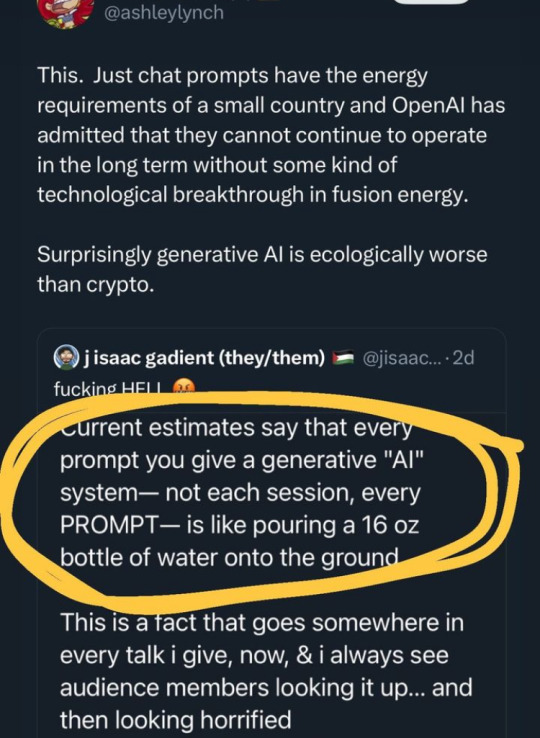
#rb#ai#okay phew I think that’s everything right maybe? someone else take the torch from me haha#I do AI research so this is on my mind all the time#or. will be doing. starting in a few months!!!!!
63K notes
·
View notes